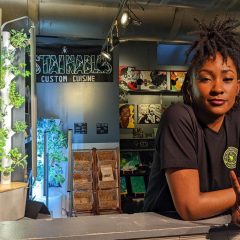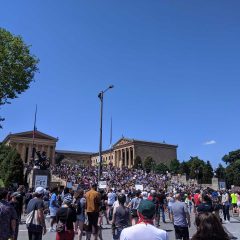Post by Andrea Kirsh
[This is the first of a two-parter.]
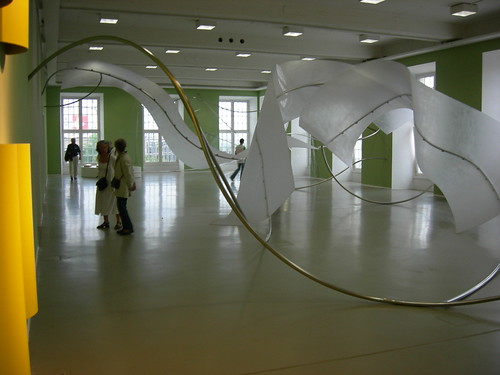
at Fridericianum – Iole de Freitas: detail of an untitled installation; the piece had one component that hung from the building on the outside; the yellow piece at the left is by Charlotte Posenskeall photos in the post by Andrea Kirsh
Documenta directors are always compelled to stake out a theoretical position and Documenta XII was no exception. The rhetoric–of the “exhibition as a medium, the move away from representation towards production” and “the three leitmotifs of the exhibition – questions on modernity, bare life and education”–made neither more nor less sense than such statements ever do; perhaps it sounds better in German. But the organizers made two points with considerably more clarity: that “the big exhibition has no form,” and that their selection was not an attempt simply to line up the best artists in the world.
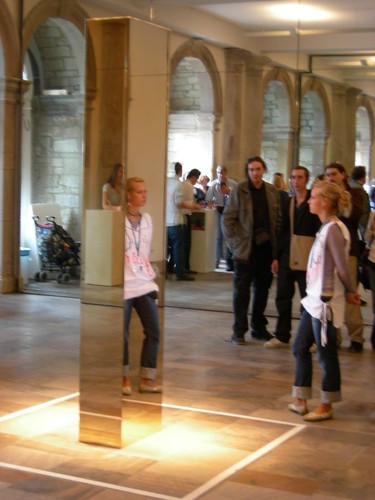
John McCracken mirrored column, untitled, 2007 bronze; in the room where one entered the Fridericianum
Documenta XII was not about art stars, either already-established ones or touts for the future. A large number of artists were from out-of-the-way places and had never shown beyond their country of residence or their regions, or at best had made it to such un-fashionable venues as Havana, Helsinki or Seville. You’re not out of the loop if you’ve never heard of Graciela Carnevale, Iole de Freitas, Annie Pootoogook, or C. K. Rajan. The artists already established in the Euro-American art world were also a very interesting, but non-canonical group: Eleanor Antin, Mary Kelly, Louise Lawler, Agnes Martin, Kerry James Marshall, John McCracken, Yvonne Rainer, Gerhard Richter (the one “star,” represented by a single, atypical painting: a small, sweet portrait of his young daughter), Martha Rosler, Allan Sekula.
Three overriding ideas
As the lists makes clear, the exhibition took women and their concerns very seriously, which was perhaps its most radical aspect. But I came away with three overriding ideas that the selection emphasized: firstly, that mankind’s history has always consisted of one culture confronting another, often with exploitation and violence; secondly, that art is always a product of cultural miscegenation; and thirdly, that the world is filled with interesting artists who in various ways are confronting large questions about the contemporary world and the position of art, and what we should be doing is looking harder, particularly in our own back yards.
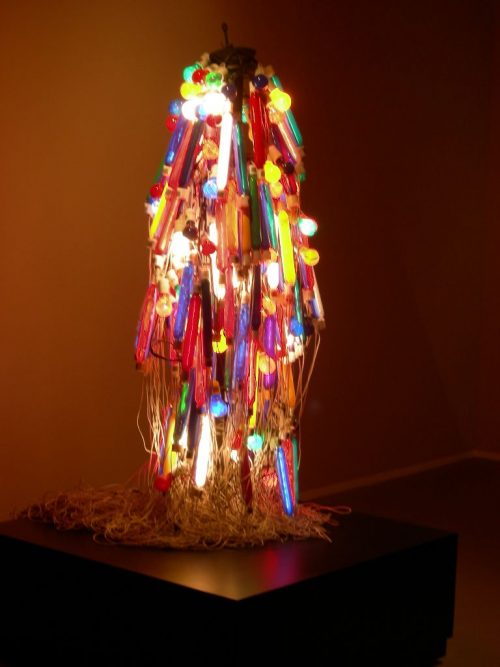
More than any Documenta I’ve seen, this one presented the work de-contextualized and a-historically but with a great sensitivity for its visual aspect: many of the walls were strongly-colored (red on the ground floor of the Museum Fridericianum, green on the first floor and flamingo-pink in part of the Neue Galerie), and works were often juxtaposed primarily to create visual rhymes, so an Agnes Martin grid painting (1964) was next to Nasreen Mohamedi’s highly-geometric drawings (done in the 1970s; their grid structures occasionally resembled weaving studies), which in turn were hung in a room with a twentieth-century, woven wool hanging from Mali. The curators said they wanted visitors to confront the art directly, and while the art historian in me was skeptical, I suspect that for most visitors it worked.
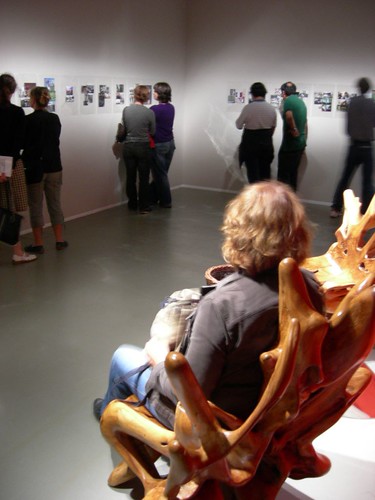
Louis Jacob: on walls, “Album III” 2004 image montage in laminated sheets; chair in foreground is part of the installation” ” A Dance for Those of Us Whose Hearts Have Turned to Ice, Based on the Choreography of Francoise Sullivan and the Sculpture of Barbara Hepworth (With Sign-Language Supplement)” 2007; 3-channel video installation with assorted objects
Perhaps the work most paradigmatic of the curators’ own approach was Louis Jacob’s “Album III” (2004) which was set out around the periphery of a large gallery in the Fridericianum; Jacob assembled pages of composite imagery, many of recent artworks (all unlabeled) which became a game of identification for the visually-informed. He culled pictures from postcards, art books and the pages of popular magazines. They were selected for visual isomorphism, so that Joseph Beuys, his face covered in honey and gold leaf in the performance “How to explain Pictures to a Dead Hare” (1965) initiated a sequence of masked figures that included a face swabbed with surgical bandages, Mexican boxing masks and a medical team in face masks, which transitioned to figures in KKK hoods and robes and, finally, Hugo Ball in Dada costume at the Cabaret Voltaire (1916); a riff on cubes included a LeWitt sculpture, a late Rietveld chair, various modernist tower blocks, Valie Export with a box over her naked chest in “Tap and Touch Cinema” (1968) and a John Chamberlain sculpture made from a car crushed into a cube. Jacob mined contemporary print culture the way Chinese scholars looked at stones, everywhere finding the fortuitous forms of art.
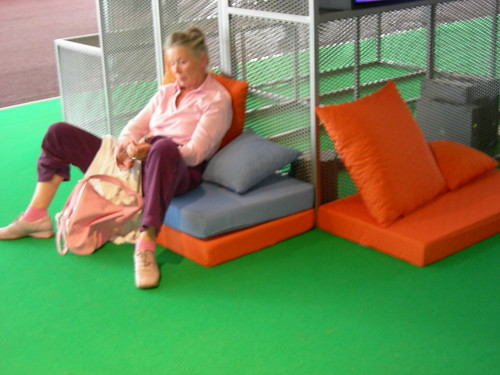
visitor taking advantage of Ricardo Basbaum’s installation “Would you like to participate in an artistic experience?” 1994-2007, 20 painted steel objects circulating in Europe, Africa and Latin America, with documentation by the participants at www.npb.pro.br
I have always attended Documenta rather late in the 100-day event, in August or even September when the fashionable crowd has come and gone and the working pieces are at risk of mechanical problems (not a big problem this year). It’s a good chance to see the range of the audience, which includes the expected international art students but also middle-class Germans of every age from infants to the elderly. Kassel is a city of enormous contrasts; the oldest public museum in Europe, in an intact neoclassical building (the Fridericianum), sits beside one of the many modern roads that scar a city badly bombed in World War II and badly re-built according to 1960s urban planning. Several hundred feet from the museum, on the main shopping street, there is still a man playing a hurdy-gurdy. He entertains the farmers and others from smaller towns in the region who come to Kassel to shop, and every five years are confronted with some of the most challenging (and occasionally blasphemous, pornographic and certainly contentious) art in the world. I’ll never forget the time I saw him, surrounded by an audience, standing not two hundred feet from a Richard Serra: a blank piece of steel which completely blocked off a street.
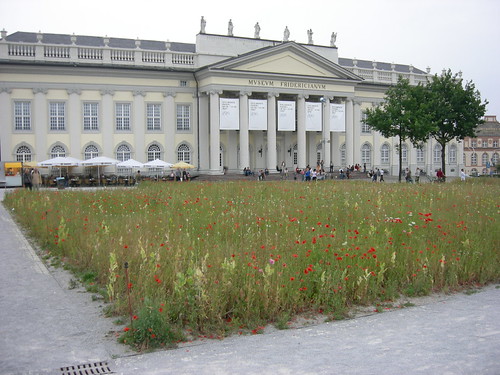
Museum Fridericianum with Friedrichsplatz planted with corn and opium poppies as part of Sanja Ivekovic’s installation “Poppy Field”
This year the most visible piece in that central location was considerably more accommodating, and indeed, poetic. Sanja Ivekovic, a performance, video and installation artist from Zagreb planted the entire square in front of the Fridericianum with poppies (90 percent corn poppy, 10 percent opium poppy). In Germany, it appears, the cultural authorities have more power than the drug enforcement officials. I also noted that it was produced with the support of the Office of Gender Equality of the Government of the Republic of Croatia, something the arts could use in Philadelphia.
“Poppy Field” offered multiple interpretations: poppies were the flower of sleep and death in antiquity, the source of the opium celebrated by romantic artists, such as De Quincy and Coleridge, and a memento of the war dead for English and Americans. The location has its own resonance for German visitors: the Friedrichplatz is associated with the culture of the Enlightenment which produced the museum, as well as the locus of Nazi marches and book-burning. Today poppies are the source of enormous contention in Afghanistan, where they’re an irresistible cash crop due to the international demand for opium. To emphasize this tension, Ivekovic had recordings of Afghan women singing revolutionary songs playing twice a day, from loudspeakers on the square.
[Read part 2 of this post on Documenta here]
–Andrea Kirsh is an art historian based in Philadelphia. You can read her recent Philadelphia Introductions articles at inLiquid.




